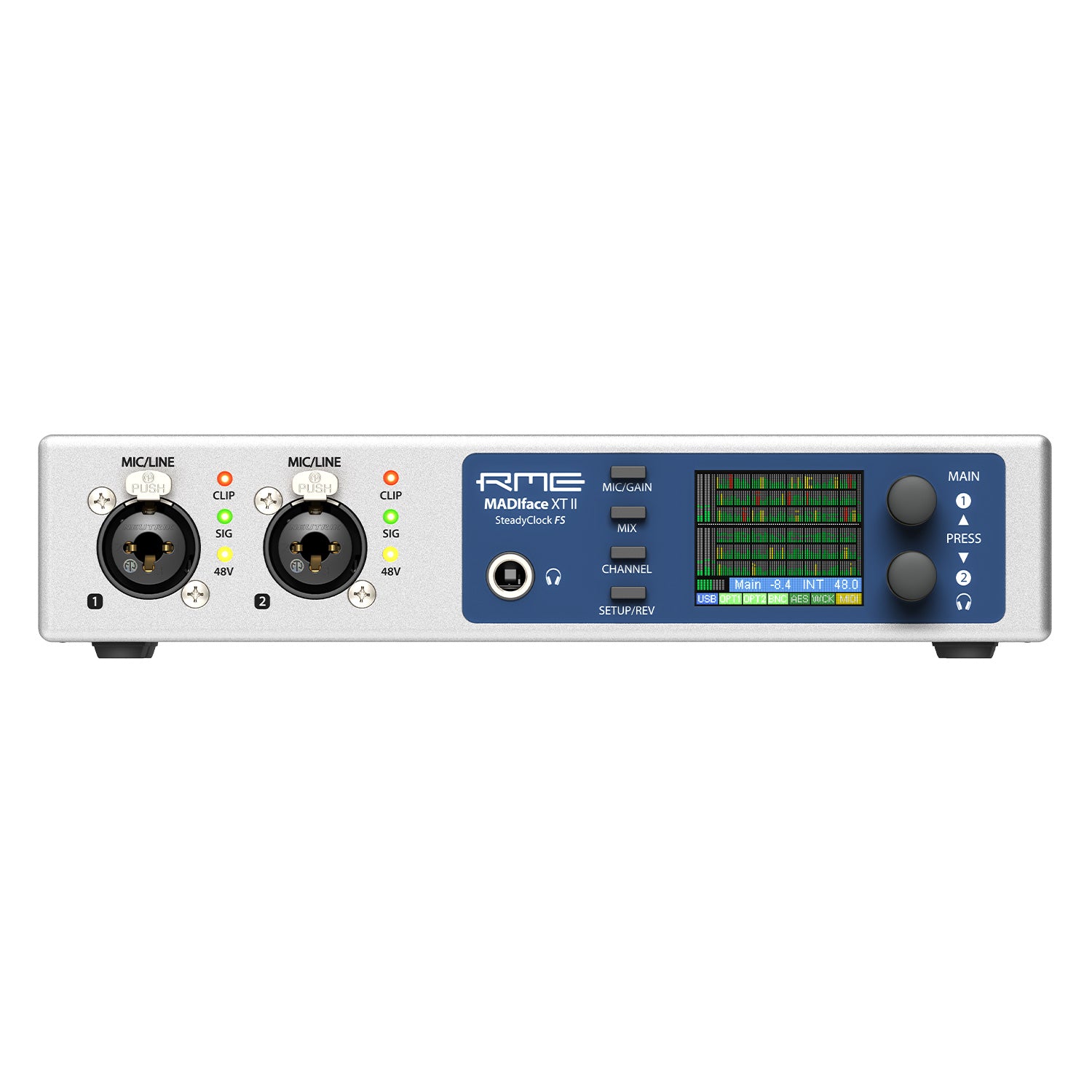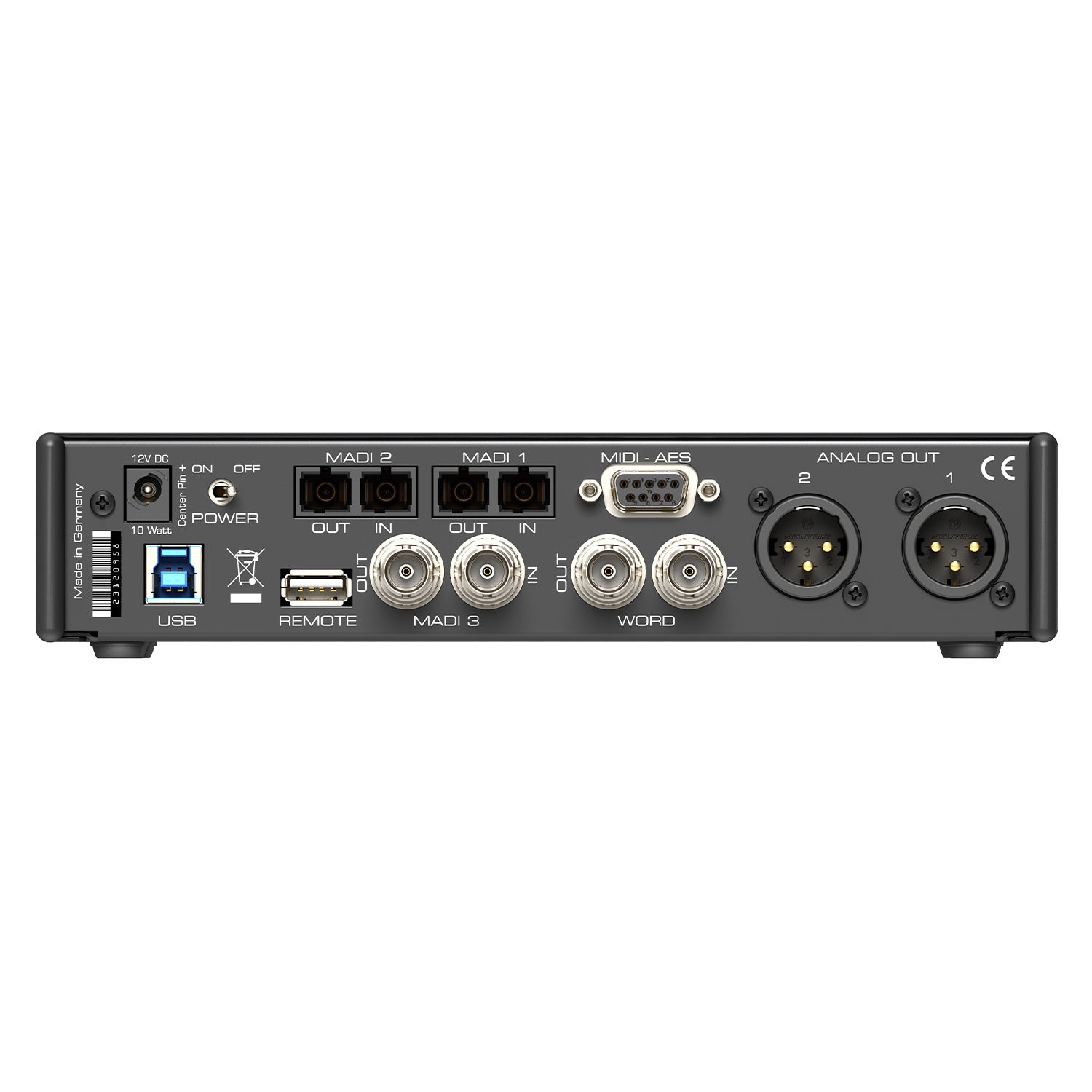
Description
RME presents the MADIface XT II a 394-channel 192 kHz USB 3.0 audio interface with comprehensive connectivity and control options for live and studio work. Compared to its predecessor MADIface XT, the MADIface XT II features updated digital and analog circuitry and surpasses the first generation with significantly improved analog and digital performance.
The MADIface XT was the world's first USB 3.0 audio interface at the time of its release - and impressed with its combination of an extremely high channel count, comprehensive connectivity and a compact desktop housing. With two practical mic/line preamps (XLR/TRS combo inputs), two balanced XLR line outputs, a stereo line headphone output, a variety of digital signal options (MADI coaxial and optical, MIDI/AES, word clock), as well as an additional PCI Express connection, the MADIface XT left nothing to be desired in terms of connectivity.
New Analog Records
The successor MADIface XT II maintains this successful formula and surpasses the signal values of its predecessor in numerous areas. Among other things, the MADIface XT II convinces with a higher signal-to-noise ratio and a lower THD value during AD conversion.
Furthermore, the maximum balanced line output level of the XLR line outputs has been increased from +15 dBu to +24 dBu. The stereo headphone output of the MADIface XT II also delivers a significantly higher output level of +19 dBu and, with an output impedance of 1 Ohm, significantly more power than its predecessor. All outputs also have several switchable level options.
New Digital Circuit Board
On the new digital board, the previous analog mini-DIN socket for remote control of individual functions has been replaced by an ARC USB remote port, which enables comprehensive control of the MADIface XT II with the optional ARC USB. The MADIface XT II also offers the Room EQ known from the Fireface UFX III with nine parametric bands for use in surround setups for up to 20 mono output channels.
Powerful Applications for Mixing, Monitoring and Measurement included
The MADIface XT II comes with the TotalMix FX DSP mixer offering comprehensive routing and monitoring options, as well as the DigiCheck Analyzer allowing to measure and analyze the digital data feed in both directions with maximum precision. TotalMix FX can completely replace an external mixer, enabling the creation of multiple latency-free monitor mixes with EQ, Dynamics, Reverb and Delay for any outputs, incl. main monitors and headphone mixes for musicians.
The additional TotalMix Remote is a remote control for TotalMix FX, to control the hardware mixer and effects in RME audio interfaces. TotalMix Remote mirrors the current state of the host system on the iPad and Windows/Mac computers - the entire mixing state, the complete routing, all FX settings, up to the level meters, and everything in real-time. Easily adjust all the mixer and FX settings from a distance, via Ethernet and WiFi.
Femtoseconds for Clocking
With the latest SteadyClock FS, the MADIface XT II features RME's latest clock and jitter rejection technology. Based on a femto clock, SteadyClock FS reduces the intrinsic jitter of the MADIface XT II to an absolute minimum, and filters clock jitter efficiently from as low as 1 Hz.
USB 3 Class Compliant Audio
The MADIface XT II operates in two different modes: driver-based USB 3 and Class Compliant. The Class Compliant mode is a standard that is natively supported by operating systems like Windows, Mac OSX and Linux distributions. No proprietary drivers are required, the device will be directly recognized when the CC firmware is loaded.
The new MADIface XT II focuses on USB 3.0, as PCIExpress can no longer be used externally. The new device's Class Compliant mode has been significantly upgraded, as all 394 channels can now be transmitted simultaneously without a driver. In addition, there are various formats and settings for the channel sequence in order to make optimum use of Class Compliant.
ARC USB Remote Control - Plug'n Play Plus
The optional available ARC USB connects to your computer via USB, and talks to TotalMix FX directly. It has 15 freely assignable and illuminated buttons, one encoder wheel, and a TS jack to connect a foot switch.
The ARC USB is a USB 1.1 MIDI remote control for the MADIface XT II. Thanks to operating as a UAC 1 class device, it is natively compatible to Windows and Mac OS X. As soon as it is present in the operating system, TotaIMix FX will automatically detect the ARC USB, and communicate with it via simple MIDI remote commands to control the XT II.
TotalMix FX - Mixing/Routing with superior features for Studio and Live Work
Since 2001 TotalMix added unlimited routing and mixing to RME's audio interfaces. Its unique capability to create as many independent submixes as output channels available turned it into the most flexible and powerful mixer of its kind.
DigiCheck - The Secret Weapon of High Resolution Audio Measurements
RME Audio interfaces not only provide you with a professional digital audio interface, but also with a free available software tool: DigiCheck, for metering, testing, measuring and analyzing digital audio streams.
SteadyClock FS - Reference class Digital Clocking
Excellent performance in all clock modes and High Quality Analog Conversion to hear your mix as it is, with lowest jitter and highest jitter immunity.
About MADI - Multi Channel Digital Audio Protocol
MADI is a protocol that has evolved alongside RME to be the most widely accepted multi channel digital audio protocol on the market. RME's MADI-based systems deliver incredible reliability, particularly in applications where failure is not an option.
Room EQ in TotalMix FX
The latest Room EQ addition provides an optimized handling of the existing 3-band PEQ in TotalMix FX, including 9-band PEQ, Volume Calibration and Crossfeed function.
| AD, Microphone/Line 1-2 | Input: XLR, electronically balanced Input impedance @ 1 kHz: 3.3 kOhm Signal to Noise ratio (SNR): 116 dB (AES17), 118.5 dBA Frequency response @ 44.1 kHz, -0.1 dB: 5 Hz Ð 20.8 kHz Frequency response @ 96 kHz, -0.5 dB: 3 Hz Ð 45.2 kHz Frequency response @ 192 kHz, -1 dB: 2 Hz - 89 kHz Filter: Short Delay Sharp, 5 / 5 / 6 samples delay THD: < -110 dB, < 0.00032 % THD+N: < -104 dB, < 0.00063 % Channel separation:> 110 dB Gain range: 75 dB Maximum input level, Gain 0 dB: +18 dBu Maximum input level, Gain 75 dB: -57 dBu CLIP LED: 0 dBFS SIG LED: -60 dBFS |
| AD, TRS As Microphone/Line 1-2, but: |
Input: 6.3 mm TRS jack, balanced Input impedance: 6.6 kOhm balanced, 3.3 kOhm unbalanced Maximum input level TRS, Gain 0 dB: +24 dBu Maximum input level TRS, Gain 60 dB: -51 dBu |
| DA, Line Out 1-2 | Dynamic range (DR): 113.5 dB (AES17), 116 dBA Frequency response @ 44.1 kHz, -0.1 dB: 0 Hz Ð 20.2 kHz Frequency response @ 96 kHz, -0.5 dB: 0 Hz Ð 44.7 kHz Frequency response @ 192 kHz, -1 dB: 0 Hz Ð 78 kHz kHz Filter: Short Delay Sharp, 6 samples delay THD+N @ -1 dBFS: -105 dB, 0.0005 % Channel separation:> 110 dB Output: XLR balanced Output level switchable +24 dBu, +19 dBu, +13 dBu, +4 dBu Output impedance: 150 Ohm |
| DA, Phones 3/4 As DA Line Out, but: |
Output: 6.3 mm TRS jack, unbalanced Output impedance: 1 Ohm Output level at 0 dBFS: +7 dBu |
| Digital Inputs | |
| MADI | Coaxial via BNC, 75 Ohm, according to AES10-1991 High-sensitivity input stage (< 0.2 Vpp) Optical via FDDI duplex SC connector 62.5/125 and 50/125 compatible Accepts 56 channel and 64 channel mode, plus 96k Frame Standard: up to 64 channels 24 bit 48 kHz S/MUX: up to 32 channels 24 bit 96 kHz S/MUX4: up to 16 channels 24 bit 192 kHz Lock range: 25 kHz Ð 54 kHz Jitter suppression:> 50 dB (> 315 Hz) |
| AES/EBU | 1 x XLR, transformer-balanced, galvanically isolated, according to AES3-1992 High-sensitivity input stage (< 0.35 Vpp) SPDIF compatible (IEC 60958) Accepts Consumer and Professional format Lock range: 27 kHz Ð 200 kHz Jitter suppression:> 50 dB (> 315 Hz) |
| Word Clock | BNC, not terminated (4 kOhm) Switchable internal termination 75 Ohm Automatic Double/Quad Speed detection and conversion to Single Speed SteadyClock guarantees super low jitter synchronization even in varispeed operation Not effected by DC-offsets within the network Signal Adaptation Circuit: signal refresh through auto-center and hysteresis Overvoltage protection Level range: 1.2 Vss Ð 5.6 Vpp Lock range: 28 kHz Ð 200 kHz Jitter suppression:> 50 dB (> 315 Hz) |
| Digital Outputs | |
| MADI | Coaxial via BNC, 75 Ohm, according to AES10-1991 Output voltage 450 mVpp Cable length: up to 100 m Optical via FDDI duplex SC connector 62.5/125 and 50/125 compatible Cable length: up to 2000 m Generates 56 channel and 64 channel mode, plus 96k Frame Standard: up to 64 channels 24 bit 48 kHz S/MUX / 96k Frame: up to 32 channels 24 bit 96 kHz S/MUX4: up to 16 channels 24 bit 192 kHz |
| AES/EBU | XLR, transformer-balanced, galvanically isolated, according to AES3-1992 Output level Professional 4.0 Vpp Format Professional according to AES3-1992 Amendment 4 Output level Consumer 2.0 Vpp Format Consumer (SPDIF) according to IEC 60958 Single Wire mode, sample rate 28 kHz up to 200 kHz |
| Word Clock | BNC Max. output voltage: 5 Vpp Output voltage @ 75 Ohm termination: 4.0 Vpp Output impedance: 22 Ohm Frequency range: 28 kHz Ð 200 kHz |
| Digital | Clocks: Internal, MADI In, Word Clock In, AES In Jitter suppression of external clocks:> 50 dB (> 315 Hz) Effective clock jitter influence on AD and DA conversion: near zero Input PLL ensures zero dropout, even at more than 100 ns jitter Supported sample rates: 28 kHz up to 200 kHz |
| MIDI | 1 x MIDI I/O via breakout cable 3 x MIDI I/O via MADI Separate 128 byte FIFO for input and output MIDI state machine in hardware for reduced interrupt request load Invisible transmission via User bit of channel 56 (up to 48 kHz) Invisible transmission via User bit of channel 28 (up to 96 kHz) |
| General | |
| Power supply | external power supply |
| Typical power consumption | 9 Watts |
| Current at 12 Volt operating voltage, idle | 750 mA (9 Watts) |
| Dimensions incl. rack ears, full depth (WxHxD) | 265 x 44 x 159 mm (10.5" x 1.73" x 6.26") |
| Dimensions without rack ears, body depth (WxHxD) | 215 x 44 x 130 mm (8.5" x 1.73" x 5.1") |
| Weight | 1.03 kg ( 2.2 lbs) |
| Temperature range | +5¡ up to +50¡ Celsius (41¡ F up to 122¡F) |
| Relative humidity | < 75%, non condensing |
| Included power supply | Internal switching PSU, 100 - 240 V AC, 2 A, 24 Watts |
RME presents the MADIface XT II a 394-channel 192 kHz USB 3.0 audio interface with comprehensive connectivity and control options for live and studio work. Compared to its predecessor MADIface XT, the MADIface XT II features updated digital and analog circuitry and surpasses the first generation with significantly improved analog and digital performance.
The MADIface XT was the world's first USB 3.0 audio interface at the time of its release - and impressed with its combination of an extremely high channel count, comprehensive connectivity and a compact desktop housing. With two practical mic/line preamps (XLR/TRS combo inputs), two balanced XLR line outputs, a stereo line headphone output, a variety of digital signal options (MADI coaxial and optical, MIDI/AES, word clock), as well as an additional PCI Express connection, the MADIface XT left nothing to be desired in terms of connectivity.
New Analog Records
The successor MADIface XT II maintains this successful formula and surpasses the signal values of its predecessor in numerous areas. Among other things, the MADIface XT II convinces with a higher signal-to-noise ratio and a lower THD value during AD conversion.
Furthermore, the maximum balanced line output level of the XLR line outputs has been increased from +15 dBu to +24 dBu. The stereo headphone output of the MADIface XT II also delivers a significantly higher output level of +19 dBu and, with an output impedance of 1 Ohm, significantly more power than its predecessor. All outputs also have several switchable level options.
New Digital Circuit Board
On the new digital board, the previous analog mini-DIN socket for remote control of individual functions has been replaced by an ARC USB remote port, which enables comprehensive control of the MADIface XT II with the optional ARC USB. The MADIface XT II also offers the Room EQ known from the Fireface UFX III with nine parametric bands for use in surround setups for up to 20 mono output channels.
Powerful Applications for Mixing, Monitoring and Measurement included
The MADIface XT II comes with the TotalMix FX DSP mixer offering comprehensive routing and monitoring options, as well as the DigiCheck Analyzer allowing to measure and analyze the digital data feed in both directions with maximum precision. TotalMix FX can completely replace an external mixer, enabling the creation of multiple latency-free monitor mixes with EQ, Dynamics, Reverb and Delay for any outputs, incl. main monitors and headphone mixes for musicians.
The additional TotalMix Remote is a remote control for TotalMix FX, to control the hardware mixer and effects in RME audio interfaces. TotalMix Remote mirrors the current state of the host system on the iPad and Windows/Mac computers - the entire mixing state, the complete routing, all FX settings, up to the level meters, and everything in real-time. Easily adjust all the mixer and FX settings from a distance, via Ethernet and WiFi.
Femtoseconds for Clocking
With the latest SteadyClock FS, the MADIface XT II features RME's latest clock and jitter rejection technology. Based on a femto clock, SteadyClock FS reduces the intrinsic jitter of the MADIface XT II to an absolute minimum, and filters clock jitter efficiently from as low as 1 Hz.
USB 3 Class Compliant Audio
The MADIface XT II operates in two different modes: driver-based USB 3 and Class Compliant. The Class Compliant mode is a standard that is natively supported by operating systems like Windows, Mac OSX and Linux distributions. No proprietary drivers are required, the device will be directly recognized when the CC firmware is loaded.
The new MADIface XT II focuses on USB 3.0, as PCIExpress can no longer be used externally. The new device's Class Compliant mode has been significantly upgraded, as all 394 channels can now be transmitted simultaneously without a driver. In addition, there are various formats and settings for the channel sequence in order to make optimum use of Class Compliant.
ARC USB Remote Control - Plug'n Play Plus
The optional available ARC USB connects to your computer via USB, and talks to TotalMix FX directly. It has 15 freely assignable and illuminated buttons, one encoder wheel, and a TS jack to connect a foot switch.
The ARC USB is a USB 1.1 MIDI remote control for the MADIface XT II. Thanks to operating as a UAC 1 class device, it is natively compatible to Windows and Mac OS X. As soon as it is present in the operating system, TotaIMix FX will automatically detect the ARC USB, and communicate with it via simple MIDI remote commands to control the XT II.
TotalMix FX - Mixing/Routing with superior features for Studio and Live Work
Since 2001 TotalMix added unlimited routing and mixing to RME's audio interfaces. Its unique capability to create as many independent submixes as output channels available turned it into the most flexible and powerful mixer of its kind.
DigiCheck - The Secret Weapon of High Resolution Audio Measurements
RME Audio interfaces not only provide you with a professional digital audio interface, but also with a free available software tool: DigiCheck, for metering, testing, measuring and analyzing digital audio streams.
SteadyClock FS - Reference class Digital Clocking
Excellent performance in all clock modes and High Quality Analog Conversion to hear your mix as it is, with lowest jitter and highest jitter immunity.
About MADI - Multi Channel Digital Audio Protocol
MADI is a protocol that has evolved alongside RME to be the most widely accepted multi channel digital audio protocol on the market. RME's MADI-based systems deliver incredible reliability, particularly in applications where failure is not an option.
Room EQ in TotalMix FX
The latest Room EQ addition provides an optimized handling of the existing 3-band PEQ in TotalMix FX, including 9-band PEQ, Volume Calibration and Crossfeed function.
| AD, Microphone/Line 1-2 | Input: XLR, electronically balanced Input impedance @ 1 kHz: 3.3 kOhm Signal to Noise ratio (SNR): 116 dB (AES17), 118.5 dBA Frequency response @ 44.1 kHz, -0.1 dB: 5 Hz Ð 20.8 kHz Frequency response @ 96 kHz, -0.5 dB: 3 Hz Ð 45.2 kHz Frequency response @ 192 kHz, -1 dB: 2 Hz - 89 kHz Filter: Short Delay Sharp, 5 / 5 / 6 samples delay THD: < -110 dB, < 0.00032 % THD+N: < -104 dB, < 0.00063 % Channel separation:> 110 dB Gain range: 75 dB Maximum input level, Gain 0 dB: +18 dBu Maximum input level, Gain 75 dB: -57 dBu CLIP LED: 0 dBFS SIG LED: -60 dBFS |
| AD, TRS As Microphone/Line 1-2, but: |
Input: 6.3 mm TRS jack, balanced Input impedance: 6.6 kOhm balanced, 3.3 kOhm unbalanced Maximum input level TRS, Gain 0 dB: +24 dBu Maximum input level TRS, Gain 60 dB: -51 dBu |
| DA, Line Out 1-2 | Dynamic range (DR): 113.5 dB (AES17), 116 dBA Frequency response @ 44.1 kHz, -0.1 dB: 0 Hz Ð 20.2 kHz Frequency response @ 96 kHz, -0.5 dB: 0 Hz Ð 44.7 kHz Frequency response @ 192 kHz, -1 dB: 0 Hz Ð 78 kHz kHz Filter: Short Delay Sharp, 6 samples delay THD+N @ -1 dBFS: -105 dB, 0.0005 % Channel separation:> 110 dB Output: XLR balanced Output level switchable +24 dBu, +19 dBu, +13 dBu, +4 dBu Output impedance: 150 Ohm |
| DA, Phones 3/4 As DA Line Out, but: |
Output: 6.3 mm TRS jack, unbalanced Output impedance: 1 Ohm Output level at 0 dBFS: +7 dBu |
| Digital Inputs | |
| MADI | Coaxial via BNC, 75 Ohm, according to AES10-1991 High-sensitivity input stage (< 0.2 Vpp) Optical via FDDI duplex SC connector 62.5/125 and 50/125 compatible Accepts 56 channel and 64 channel mode, plus 96k Frame Standard: up to 64 channels 24 bit 48 kHz S/MUX: up to 32 channels 24 bit 96 kHz S/MUX4: up to 16 channels 24 bit 192 kHz Lock range: 25 kHz Ð 54 kHz Jitter suppression:> 50 dB (> 315 Hz) |
| AES/EBU | 1 x XLR, transformer-balanced, galvanically isolated, according to AES3-1992 High-sensitivity input stage (< 0.35 Vpp) SPDIF compatible (IEC 60958) Accepts Consumer and Professional format Lock range: 27 kHz Ð 200 kHz Jitter suppression:> 50 dB (> 315 Hz) |
| Word Clock | BNC, not terminated (4 kOhm) Switchable internal termination 75 Ohm Automatic Double/Quad Speed detection and conversion to Single Speed SteadyClock guarantees super low jitter synchronization even in varispeed operation Not effected by DC-offsets within the network Signal Adaptation Circuit: signal refresh through auto-center and hysteresis Overvoltage protection Level range: 1.2 Vss Ð 5.6 Vpp Lock range: 28 kHz Ð 200 kHz Jitter suppression:> 50 dB (> 315 Hz) |
| Digital Outputs | |
| MADI | Coaxial via BNC, 75 Ohm, according to AES10-1991 Output voltage 450 mVpp Cable length: up to 100 m Optical via FDDI duplex SC connector 62.5/125 and 50/125 compatible Cable length: up to 2000 m Generates 56 channel and 64 channel mode, plus 96k Frame Standard: up to 64 channels 24 bit 48 kHz S/MUX / 96k Frame: up to 32 channels 24 bit 96 kHz S/MUX4: up to 16 channels 24 bit 192 kHz |
| AES/EBU | XLR, transformer-balanced, galvanically isolated, according to AES3-1992 Output level Professional 4.0 Vpp Format Professional according to AES3-1992 Amendment 4 Output level Consumer 2.0 Vpp Format Consumer (SPDIF) according to IEC 60958 Single Wire mode, sample rate 28 kHz up to 200 kHz |
| Word Clock | BNC Max. output voltage: 5 Vpp Output voltage @ 75 Ohm termination: 4.0 Vpp Output impedance: 22 Ohm Frequency range: 28 kHz Ð 200 kHz |
| Digital | Clocks: Internal, MADI In, Word Clock In, AES In Jitter suppression of external clocks:> 50 dB (> 315 Hz) Effective clock jitter influence on AD and DA conversion: near zero Input PLL ensures zero dropout, even at more than 100 ns jitter Supported sample rates: 28 kHz up to 200 kHz |
| MIDI | 1 x MIDI I/O via breakout cable 3 x MIDI I/O via MADI Separate 128 byte FIFO for input and output MIDI state machine in hardware for reduced interrupt request load Invisible transmission via User bit of channel 56 (up to 48 kHz) Invisible transmission via User bit of channel 28 (up to 96 kHz) |
| General | |
| Power supply | external power supply |
| Typical power consumption | 9 Watts |
| Current at 12 Volt operating voltage, idle | 750 mA (9 Watts) |
| Dimensions incl. rack ears, full depth (WxHxD) | 265 x 44 x 159 mm (10.5" x 1.73" x 6.26") |
| Dimensions without rack ears, body depth (WxHxD) | 215 x 44 x 130 mm (8.5" x 1.73" x 5.1") |
| Weight | 1.03 kg ( 2.2 lbs) |
| Temperature range | +5¡ up to +50¡ Celsius (41¡ F up to 122¡F) |
| Relative humidity | < 75%, non condensing |
| Included power supply | Internal switching PSU, 100 - 240 V AC, 2 A, 24 Watts |
Your home for all things pro audio—backed by expertise and experience. Connect with us today.
Your home for all things pro audio—backed by expertise and experience. Connect with us today.



